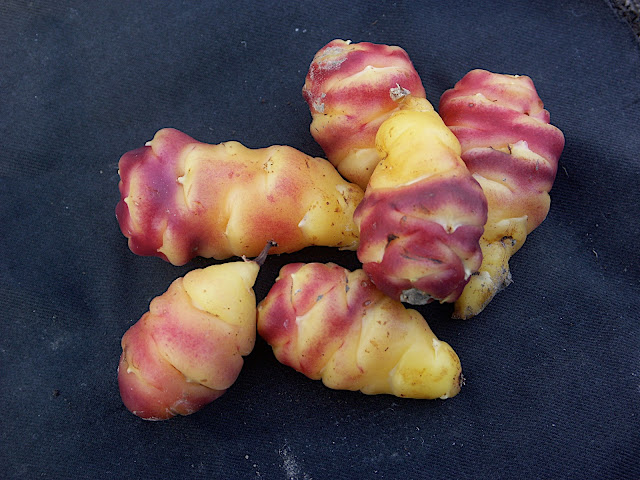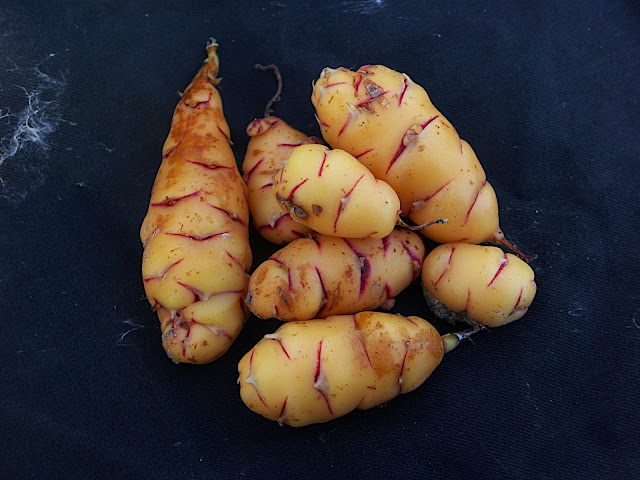|
|
Post by spacecase0 on Feb 25, 2010 16:01:39 GMT -5
If it never freezes - you lucky person! I don't get summer either, it is like living in a refrigerator year round. |
|
|
|
Post by spacecase0 on Feb 25, 2010 16:02:50 GMT -5
I lost all the surface tubers from the white oca to hard frosts (for England - down to -7), but the red wasn't affected. A lot of plants produced nothing, but the original tubers were very small, and planted late. I planted again the day before yesterday, and I'm hoping for a better crop this year! so are you planting new ones ? or seeds, or the red ones that lived last year ? |
|
|
|
Post by robertb on Feb 25, 2010 16:38:57 GMT -5
Tubers from last year. Rather larger ones this time.
|
|
|
|
Post by canadamike on Feb 25, 2010 18:51:53 GMT -5
Hey guys, we have more than doubled membership since we discussed oca a lot last year. Could each of you try do describe oca's taste as you percieve it? TRying to relate it to known stuff if possible could help.
Frank, could you do the same with mashua and yacon? Or anybody else for that matter...
|
|
|
|
Post by ianpearson on Feb 26, 2010 14:04:17 GMT -5
The thing is, the taste of oca changes. When first lifted, it is sharper (more acidic) and has a higher water content. With even a couple of weeks of storage, the acid taste reduces, and it becomes more potato-like in texture as the water content reduces - but never really becomes floury. Raw, they are like a sour(in a good or bad way, depending on acid content) radishy parsnipy taste, but cooked, especially roasted or fried, it becomes a vegetable that can happily be eaten in bulk, as a side vegetable, or in stir fries. There seems to be variation in taste between varieties too. Oca tastes good (as obscure vegetables go), but is nothing compared to yacon. It is so delicious. It is another one that improves with storage, getting sweeter, and loosing the slight hint of indigestibility that it has when lifted too early and eaten straight away. The cooked taste is like warm pear with the wet sloppiness removed and a pleasant crunchiness added. That's the best way I can describe it, but then I'm an insensitive inarticulate grunt. oca-testbed.blogspot.com/ |
|
|
|
Post by robertb on Feb 26, 2010 15:23:05 GMT -5
Sort of lemony but sweet. I find tastes pretty much indescribable.
|
|
|
|
Post by canadamike on Feb 26, 2010 22:10:48 GMT -5
Ian, you are a poet my friend. I have tasted them reading your words.
Thank you for that privilege.
Michel
|
|
|
|
Post by ianpearson on Feb 27, 2010 2:55:33 GMT -5
Why, thank you Canadamike. I had yacon and pork fried rice for my meal last night, and tried to concentrate on the yacon taste. I'll stick with the warm pear, but I also detected a hint of pineapple. I think that's the limit of my descriptive powers. oca-testbed.blogspot.com/ |
|
|
|
Post by orflo on Feb 28, 2010 8:42:03 GMT -5
You can sweeten up oca completely, by placing it in the sun for a few weeks. It goes faster in the Andes, but sunlight is more intense in these tropical and subtropical regions. Make sure they are frost-free, put them on a window-sill, in a greenhouse, or wherever there's a nice spot. Also, take care that they don't dry out rapidly, otherwise they could start to shrivel (high air humidity is important). My best spot is an unheated greenhouse (air humidity is very high in winter), but they need some covering during cold spells. The ocas can sweeten up so much that they can be eaten out of hand. Some varieties are even used to make some desserts out of them, not much sugar has to be added, all the acidity has disappeared and a quite sweet taste appears.  You can do the same with yacon, place the tubers in the sun, again frost-free. And they are best eaten when the skin gets wrinkled, and the tubers are a bit on the softer side. Sweetness is much higher then, I even had tubers that had a very distinct alcohol taste! A word on getting an earlier crop from the daylength-sensitive tubers (oca, mashua, ullucus,..). You can get an earlier crop from these by reducing the natural daylight artificially. By the beginning/middle of August you can place some black plastic or whatever you have lying about onto the plants, for a period of about fourteen days. During that period, you have to remove the plastic for about 9 hours each day, so they get an impression that they are in some sort of a short-day cycle. This works very well in areas with early frosts (harvest can be as early as half October with this method) and can also increase the harvest and can make sure you get bigger tubers, I've had ocas up to 12-13 cms using that method  |
|
|
|
Post by raymondo on Feb 28, 2010 15:47:39 GMT -5
Does oca produce seed for you? I've grown it (unsuccessfully) several times but the plants have never produced a flower.
|
|
|
|
Post by robertb on Mar 1, 2010 13:22:28 GMT -5
Mine flowered last year, but no seeds that I saw. I'll look more carefully this year.
|
|
|
|
Post by ianpearson on Mar 1, 2010 13:47:20 GMT -5
|
|
|
|
Post by spacecase0 on Mar 1, 2010 14:41:47 GMT -5
that is good info,
I wonder why not just hand pollinate with a small paint brush when the flowers are open ?
|
|